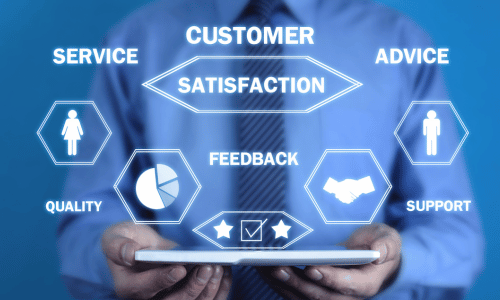
In the world of business, delivering an exceptional customer experience isn’t just a choice; it’s an imperative. Exceptional customer service isn’t merely about pleasing the customer; it’s about acquiring and retaining them, fostering brand loyalty, and ultimately driving growth. Customer-centric organizations understand this and make service a company-wide priority. They establish cultures that revolve around the customer, encourage feedback, and empower their employees to deliver excellence.
Building a Customer-Centric Culture

Creating a customer-centric culture is the bedrock upon which exceptional customer service is built. Here are some strategies that can help in achieving this:
Mission Statement
- Infuse an emphasis on customer value into the company’s mission and values messaging. Make it a fundamental part of the organization’s identity.
Customer Research
- Conduct surveys, interviews, and focus groups to gain deep insights into customer pain points and preferences. Journey mapping can be a valuable tool.
Education
- Train team members to understand and execute ideal customer interactions. Role-playing common scenarios can help hone these skills.
Removing Obstacles
- Audit processes to identify and eliminate pain points or confusion that might hinder the delivery of great service.
Customer Data
- Centrally store insights from CRM systems, reviews, and support tickets to understand your customer base better and personalize interactions.
Experience Testing
- Secret shopping or making anonymous purchases to experience your business as a customer would. This helps identify gaps and areas for improvement.
Leadership Focus
- Make customer satisfaction a key performance indicator (KPI) for managers. They should lead by example and model the desired behaviours.
Hiring for Soft Skills
- Seek candidates who are adept at building rapport, empathizing with customers, displaying patience, and communicating with clarity.
Accountability
- Include service excellence in performance management. Create incentives and rewards for those who consistently deliver exceptional service.
Ongoing Monitoring
- Consistently survey customers to gauge sentiment and satisfaction levels. Swiftly address any dips in performance.
When customer obsession becomes an integral part of every team, process, and activity within the organization, you have truly achieved a customer-centric culture.
Encouraging and Managing Feedback

Proactively seeking customer insights through feedback is essential for business growth. Here are some best practices in this regard:
Surveys
- Email short post-interaction surveys to gauge satisfaction and identify areas for improvement.
Reviews
- Monitor online review sites diligently. Respond promptly and courteously to negative comments to demonstrate your commitment to improvement.
Focus Groups
- Assemble existing customers to test ideas and share detailed opinions in a group environment. Their insights can be invaluable.
Suggestion Forms
- Provide online forms or in-store comment cards for customers to submit ideas and input easily. Make it convenient for them to share their thoughts.
Customer Advisory Panels
- For larger companies, create a diverse panel of customers who meet regularly to weigh in on various initiatives and provide feedback.
Incentives
- Offer perks like discounts to encourage customers to provide quality feedback. It not only helps you but also makes customers feel valued.
Live Chat
- Enable real-time commentary from browsing customers through instant chat. It’s a great way to gather feedback as it happens.
Complaint Resolution
- Establish and prominently share simple complaint submission processes. Address complaints respectfully and promptly to win back trust.
Social Listening
- Monitor social channels for brand mentions to gauge sentiment and understand customer experiences outside of your controlled channels.
Soliciting feedback through multiple convenient channels and quickly implementing insights to fulfill unmet needs is crucial in this customer-centric approach.
Empowering Employees

Customer-centricity requires employees to feel supported in delivering excellent service. Empower your staff to promptly assist customers by:
Providing Needed Resources
- Ensure there are adequate staffing levels, sufficient product inventories, and the right tech tools and training to meet customer needs.
Minimizing Red Tape
- Remove bureaucratic obstacles that hinder your frontline employees from efficiently solving customer issues.
Responding to Ideas
- Listen to employee suggestions on how to improve the customer experience. Test and implement these ideas when feasible.
Recognizing Success
- Acknowledge and celebrate above-and-beyond service efforts by your employees. Feature their achievements in internal communications to inspire others.
Handling Mistakes Professionally
- Establish processes for constructively addressing service gaps without assigning blame. Focus on systemic factors over individual error.
Surveying Staff
- Regularly gauge employee satisfaction and identify obstacles they face when servicing customers.
Fostering Collaboration
- Facilitate teamwork between departments to ensure seamless customer experiences across various touchpoints.
Empowered and valued employees are the backbone of exceptional customer service. They enable companies to offer customer service excellence, which, in turn, drives customer loyalty and referrals.
In conclusion, by instilling a customer-first mindset throughout the organization, proactively seeking feedback, and removing roadblocks for staff, businesses gain actionable insights that enable them to offer unmatched customer experiences. Customer satisfaction becomes not just a goal but a competitive differentiator that propels the organization to greater heights.
We’ve unpacked a lot today at Biz Step Ladder, and now it’s your turn to add to the dialogue. Do you have insights or experiences that could expand on what we’ve discussed? Perhaps you’ve identified an angle we haven’t covered. Jump into the conversation below with your comments and let’s continue the learning journey together. Your input is not just welcome—it’s a vital part of our community’s growth. So, what are your thoughts? Share them below and let’s enrich our business wisdom collectively!
Discover related content by exploring Starting a business, common pitfalls, and resources for new entrepreneurs.





